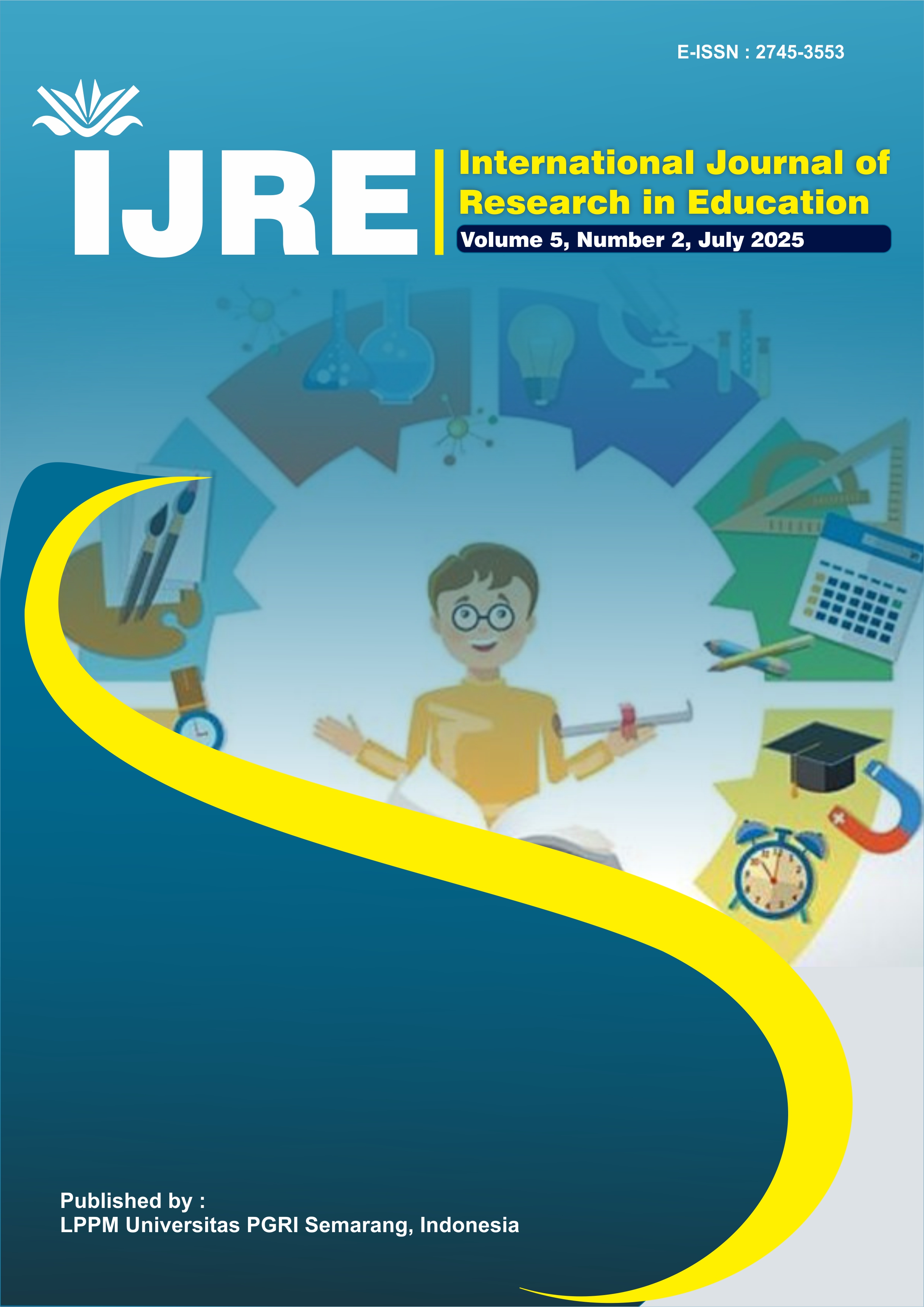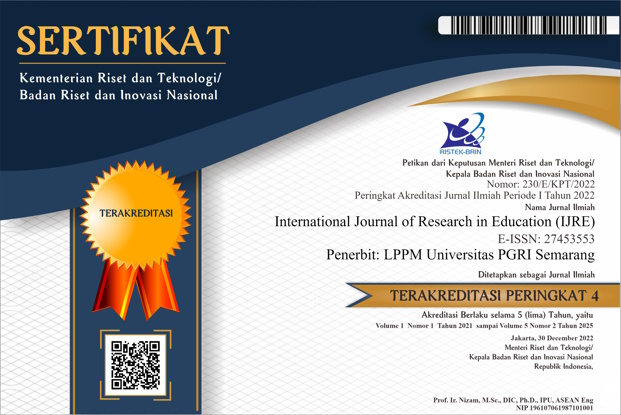Improving Students’ Writing Ability Using Digital Multimodal Composition at SMAN 1 Katibung
DOI:
https://doi.org/10.26877/rmjj5g29Keywords:
Digital Multimodal Composition, Writing Skills, Classroom Action ResearchAbstract
This research aims to enhance the descriptive writing abilities of tenth-grade pupils at SMAN 1 Katibung through Digital Multimodal Composition. The study showed that tenth-grade students faced difficulties in writing due to issues such as a limited vocabulary, grammatical structures, and expressing their ideas effectively. The research design is Classroom Action Research (CAR) following the approach of Kemmis and McTaggart, which includes 4 stages: planning, action, observation, and reflection. The research was completed over two cycles, with each cycle comprised of two meetings. The researcher utilized a writing test, observations, interviews, and document reviews as part of the methodology. The researcher using slide presentations and videos as digital media. The results demonstrated that the average score of pupils in the post-test of cycle 1 increased to 67% from 57% after the implementation of Digital Multimodal Composing media. Due to the percentage still falling short of the criteria, the researcher adjusted the plan for cycle 2, demonstrating enhancements in content, vocabulary, organization, grammatical structure, and mechanics. The difference approach taken in cycle 2 proved effective, resulting in 77% of students achieving the minimum standard score (KKM), which met the success criteria. According to the data assessment, the researcher found that the use of Digital Multimodal Composing media received positive feedback from students and enhanced their writing skills.
References
Ahmed, A. M., & Zhang, X. (2023). Students’ voice in L2 English writing: A systematic review of literature. Ampersand, 10. https://doi.org/10.1016/j.amper.2023.100114
Arthur Hughes. (2003). Arthur_Hughes_Testing_for_Language_Teac. Cambride University Press.
Berlinda Mandasari, O. L. (2018). English language learning strategies: an exploratory study of management and engineering students (Issue 2). https://fkip.ummetro.ac.id/journal/index.php/english
Blake, J. (2021). Asynchronous peer teaching using student-created multimodal materials. International Journal of Information and Education Technology, 11(6), 286–291. https://doi.org/10.18178/ijiet.2021.11.6.1524
Clark, B. D. (2018). BearWorks BearWorks MSU Graduate Theses A Matter of Value: Creative Writing Strategies and Their A Matter of Value: Creative Writing Strategies and Their Transference to Composition Transference to Composition. https://bearworks.missouristate.edu/theses
Elbashir, B. (2023). Writing Skills Problems: Causes and Solutions. International Journal of English Language Teaching, 11(5), 52–64. https://doi.org/10.37745/ijelt.13/vol1n55264
Ertan Özen, N., & Duran, E. (2021). Contribution of digital storytelling to creative thinking skills. Turkish Journal of Education, 10(4), 297–318. https://doi.org/10.19128/turje.909865
Gilster P. (1997). Digital_Literacy.
Göçer Demirel, G., Demirtaş Tolaman, T., & Azizoğlu, N. İ. (2023). Using Technology to Support Creative Writing: How It Affects Teachers’ Digital Writing Skills and Their Gains from Digital Technology. International Journal of Psychology and Educational Studies, 10(2), 422–440. https://doi.org/10.52380/ijpes.2023.10.2.1039
Harahap, N., & Ritonga, D. S. (2023). International Journal of Students Education THE ROLE OF THE TEACHER’S PROFESSION IN EDUCATION.
Harmer. (2004). Jeremy_Harmer_How_to_Teach_Writing_Longm. Academia.Edu.
Jewitt, C. (2008). Multimodality and literacy in school classrooms. Review of Research in Education, 32, 241–267. https://doi.org/10.3102/0091732X07310586
Kemmis Robin McTaggart, S. (1998). Desarrollo Organizacional The Action Research Planner.
La Oni, G. M. (2022). Exploring Students’ Writing at the English Language Education Study Program. Edusia: Jurnal Ilmiah Pendidikan Asia, 2(1), 1–19. https://doi.org/10.53754/edusia.v2i1.341
Lane, P. (2016). Animating Academic Writing Skills Through Creating Animated Educational Videos 1).
Liang, W. J., & Lim, F. V. (2021). A pedagogical framework for digital multimodal composing in the English Language classroom. Innovation in Language Learning and Teaching, 15(4), 306–320. https://doi.org/10.1080/17501229.2020.1800709
Maghsoudi, N., Golshan, M., & Naeimi, A. (2022). Integrating Digital Multimodal Composition into EFL Writing Instruction. Journal of Language and Education, 8(1), 84–99. https://doi.org/10.17323/jle.2022.12021
Miles & Huberman. (1994). Qualitative Data Analysis second edition. SAGE Publications.
Nation, I. S. P. . (2001). Learning vocabulary in another language. Cambridge University Press.
Nur, J., & Sari, M. (2022). USING WATTPAD AS A DIGITAL MULTIMODAL COMPOSING OF NARRATIVE TEXT. RETAIN, 10, 100–108.
Purnamasari, D., Nuruddin Hidayat, D., Kurniawati, L., & Syarif Hidayatullah. (2021). AN ANALYSIS OF STUDENTS’ WRITING SKILL ON ENGLISH DESCRIPTIVE TEXT (Vol. 14, Issue 1). https://ejournal.radenintan.ac.id/index.php/ENGEDU
Rahmawati, I., & Khusnun Muhsin, M. (2021). The Effect of Microsoft Office PowerPoint on Students’ Writing Competence at SMPN 9 Kendari. In JTE Journal of Teaching of English (Vol. 6, Issue 4).
Rido Achmad Yudi Wahyudin Ingatan Gulo, A. (2018). An Overview of Current Issues in Literature, Linguistics, and Language Teaching. www.teknokrat.ac.id
Ryan, R. M., & Deci, E. L. (2000). Self-Determination Theory and the Facilitation of Intrinsic Motivation, Social Development, and Well-Being Self-Determination Theory. Ryan.
S Moybeka, A. M., Hadiman Bosco, F., Rubenaser Apalem, C., & Amelia Chandra, D. (2023). Language, Literature,and Education published by English Education Department Faculty of Languages and Arts. In Culture, Language, Literature, and Education (Vol. 11, Issue 1).
Wentzel, K. R. (1997). Student Motivation in Middle School: The Role of Perceived Pedagogical Caring. In Journal of Educational Psychology (Vol. 89, Issue 3).
Xu, Y. (2023). Investigating the effects of digital multimodal composing on Chinese EFL learners’ writing performance: a quasi-experimental study. Computer Assisted Language Learning, 36(4), 785–805. https://doi.org/10.1080/09588221.2021.1945635
Yu, S., Zhang, E. Di, & Liu, C. (2024). Research into practice: Digital multimodal composition in second language writing. In Language Teaching. Cambridge University Press. https://doi.org/10.1017/S0261444824000375



